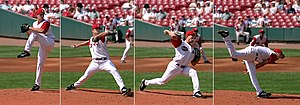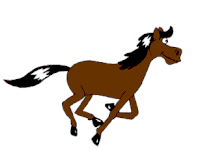Twelve basic principles of animation

The 12 basic principles of animation is a set of principles of animation introduced by the Disney animators Ollie Johnston and Frank Thomas in their 1981 book The Illusion of Life: Disney Animation.[a][1] Johnston and Thomas in turn based their book on the work of the leading Disney animators from the 1930s onwards, and their effort to produce more realistic animations. The main purpose of the principles was to produce an illusion of characters adhering to the basic laws of physics, but they also dealt with more abstract issues, such as emotional timing and character appeal.
The book and its principles have become generally adopted, and have been referred to as the 'Bible of the industry'. In 1999 the book was voted number one of the "best animation books of all time" in an online poll. Though originally intended to apply to traditional, hand-drawn animation, the principles still have great relevance for today's more prevalent computer animation.
The Illusion of Life
The term 'illusion of life' was coined by the Disney animator Hamilton Luske in the 1930s.[2] Earlier Disney cartoons had looked like little more than moving drawings, but, for the studio's upcoming feature films like Snow White (1937), there was a need for greater realism.[3] Through a thorough study of movement, the human body and artistic drawing, the animators arrived at a set of principles that would make their figures appear more life-like. The term 'illusion of life' summed up the Disney philosophy: while the Warner animator Tex Avery drew cartoons which depended on surreal humour, Disney strove for a style that was exaggerated, yet rooted in reality.[4] In Walt Disney's own words: "Our work must have a foundation of fact in order to have sincerity. The most hilarious comedy is always based on things actual".[5]
The chief animators at the Disney studios were referred to as the 'Nine Old Men'. While the animators in reality were relatively young, Walt Disney jokingly used Franklin D. Roosevelt's dismissive description of the nine justices of the US Supreme Court to describe the group.[6] Two of the 'Nine Old Men', Ollie Johnston and Frank Thomas, had worked on such animated feature films as Snow White, Cinderella and Peter Pan.[7] After their retirement they wrote the book The Illusion of Life, and by the time it was released in 1981, they had spent nearly five years in research and writing.[8][9] The book represented over forty years' experience in the field of animation, and instantly made minor celebrities of the two, a fact the Disney company knew to exploit commercially.[9]
The book has been described as the 'Bible' of the industry.[9][10] Preston Blair, in his book Cartoon Animation, calls it "An excellent and extensive work", and lists it among the five books that "Every student of art animation should read and own".[11] In a 1999 poll on the website Animation World Network, it topped the list of the "best animation books of all time".[12] The heart of the book is the set of 'basic principles', that were summed up in twelve points.[13] Most experts in the field agree that these twelve principles, when applied correctly, are comprehensive to producing an 'illusion of life'.[3] The advent of computer animation has done nothing to eliminate the relevance of the 12 basic principles, and they are often repeated in books and websites on digital animation.[3][14]
The 12 principles

Example A shows a ball bouncing with a rigid, non-dynamic movement. In example B the ball is "squashed" at impact, and "stretched" during fall and rebound. The movement also accelerates during the fall, and slows down towards the apex (see "slow in and slow out").
Squash and stretch

The most important principle is "squash and stretch",[13] the purpose of which is to give a sense of weight and flexibility to drawn objects. It can be applied to simple objects, like a bouncing ball, or more complex constructions, like the musculature of a human face.[15][16] Taken to an extreme point, a figure stretched or squashed to an exaggerated degree can have a comical effect.[17] In realistic animation, however, the most important aspect of this principle is the fact that an object's volume does not change when squashed or stretched. If the length of a ball is stretched vertically, its width (in three dimensions, also its depth) needs to contract correspondingly horizontally.[18]
Anticipation
Anticipation is used to prepare the audience for an action, and to make the action appear more realistic.[19] A dancer jumping off the floor has to bend his knees first; a golfer making a swing has to swing the club back first. The technique can also be used for less physical actions, such as a character looking off-screen to anticipate someone's arrival, or attention focusing on an object that a character is about to pick up.[20]

For special effect, anticipation can also be omitted in cases where it is expected. The resulting sense of anticlimax will produce a feeling of surprise in the viewer, and can often add comedy to a scene.[21] This is often referred to as a 'surprise gag'.[22]
Staging
This principle is akin to staging as it is known in theatre and film.[23] Its purpose is to direct the audience's attention, and make it clear what is of greatest importance in a scene; what is happening, and what is about to happen.[10] Johnston and Thomas defined it as "the presentation of any idea so that it is completely and unmistakably clear", whether that idea is an action, a personality, an expression or a mood.[23] This can be done by various means, such as the placement of a character in the frame, the use of light and shadow, and the angle and position of the camera.[24] The essence of this principle is keeping focus on what is relevant, and avoiding unnecessary detail.[25][26]
Straight ahead action and pose to pose
These are two different approaches to the actual drawing process. "Straight ahead action" means drawing out a scene frame by frame from beginning to end, while "pose to pose" involves starting with drawing a few, key frames, and then filling in the intervals later.[10] "Straight ahead action" creates a more fluid, dynamic illusion of movement, and is better for producing realistic action sequences. On the other hand, it is hard to maintain proportions, and to create exact, convincing poses along the way. "Pose to pose" works better for dramatic or emotional scenes, where composition and relation to the surroundings are of greater importance.[27] A combination of the two techniques is often used.[28]
Computer animation removes the problems of proportion related to "straight ahead action" drawing; however, "pose to pose" is still used for computer animation, because of the advantages it brings in composition.[29] The use of computers facilitates this method, as computers can fill in the missing sequences in between poses automatically. It is, however, still important to oversee this process, and apply the other principles discussed.[28]
Follow through and overlapping action
These closely related techniques help render movement more realistic, and give the impression that characters follow the laws of physics. "Follow through" means that separate parts of a body will continue moving after the character has stopped. "Overlapping action" is when a character changes direction, and parts of the body continue in the direction he was previously going. A third technique is "drag", where a character starts to move and parts of him take a few frames to catch up.[10] These parts can be inanimate objects like clothing or the antenna on a car, or parts of the body, such as arms or hair. On the human body, the torso is the core, with arms, legs, head and hair appendices that normally follow the torso's movement. Body parts with much tissue, such as large stomachs and breasts, or the loose skin on a dog, are more prone to independent movement than bonier body parts.[30] Again, exaggerated use of the technique can produce a comical effect, while more realistic animation must time the actions exactly, to produce a convincing result.[31]
Thomas and Johnston also developed the principle of the "moving hold". A character not in movement can be rendered absolutely still; this is often done, particularly to draw attention to the main action. According to Thomas and Johnston, however, this gave a dull and lifeless result, and should be avoided. Even characters sitting still can display some sort of movement, such as the torso moving in and out with breathing.[32]
Slow in and slow out
The movement of the human body, and most other objects, needs time to accelerate and slow down. For this reason, an animation looks more realistic if it has more frames near the beginning and end of a movement, and fewer in the middle.[10] This principle goes for characters moving between two extreme poses, such as sitting down and standing up, but also for inanimate, moving objects, like the bouncing ball in the above illustration.[33]
Arcs
Most human and animal actions occur along an arched trajectory, and animation should reproduce these movements for greater realism. This can apply to a limb moving by rotating a joint, or a thrown object moving along a parabolic trajectory. The exception is mechanical movement, which typically moves in straight lines.[34]

Secondary action
Adding secondary actions to the main action gives a scene more life, and can help to support the main action. A person walking can simultaneously swing his arms or keep them in his pockets, he can speak or whistle, or he can express emotions through facial expressions.[35] The important thing about secondary actions is that they emphasize, rather than take attention away from the main action. If the latter is the case, those actions are better left out.[36] In the case of facial expressions, during a dramatic movement these will often go unnoticed. In these cases it is better to include them at the beginning and the end of the movement, rather than during.[37]
Timing
Timing in reality refers to two different concepts: physical timing and theatrical timing.[38] It is essential both to the physical realism, as well as to the storytelling of the animation, that the timing is right. On a purely physical level, correct timing makes objects appear to abide to the laws of physics; for instance, an object's weight decides how it reacts to an impetus, like a push.[39] Theatrical timing is of a less technical nature, and is developed mostly through experience.[10] It can be pure comic timing, or it can be used to convey deep emotions. It can also be a device to communicate aspects of a character's personality.[40]

Exaggeration
Exaggeration is an effect especially useful for animation, as perfect imitation of reality can look static and dull in cartoons.[10] The level of exaggeration depends on whether one seeks realism or a particular style, like a caricature or the style of an artist.[38] The classical definition of exaggeration, employed by Disney, was to remain true to reality, just presenting it in a wilder, more extreme form.[42] Other forms of exaggeration can involve the supernatural or surreal, alterations in the physical features of a character, or elements in the storyline itself.[43] It is important to employ a certain level of restraint when using exaggeration; if a scene contains several elements, there should be a balance in how those elements are exaggerated in relation to each other, to avoid confusing or overawing the viewer.[44]
Solid drawing
The principle of solid — or good — drawing, really means that the same principles apply to an animator as to an academic artist.[10] The drawer has to understand the basics of anatomy, composition, weight, balance, light and shadow etc.[45] For the classical animator, this involved taking art classes and doing sketches from life.[46] One thing in particular that Johnston and Thomas warned against was creating "twins": characters whose left and right sides mirrored each other, and looked lifeless.[47] Modern-day computer animators in theory do not need to draw at all, yet their work can still benefit greatly from a basic understanding of these principles.[46][38]
Appeal
Appeal in a cartoon character corresponds to what would be called charisma in an actor.[48] A character who is appealing is not necessarily sympathetic — villains or monsters can also be appealing — the important thing is that the viewer feels the character is real and interesting.[48] There are several tricks for making a character connect better with the audience; for likable characters a symmetrical or particularly baby-like face tends to be effective.[49]
Notes
References
- ^ Thomas, Frank (1981, reprint 1997). The Illusion of Life: Disney Animation. Hyperion. pp. pp. 47–69. ISBN 0786860707.
{{cite book}}:|pages=has extra text (help); Check date values in:|date=(help); Unknown parameter|coauthors=ignored (|author=suggested) (help) - ^ Canemaker, John (2001). Walt Disney's Nine Old Men and the Art of Animation. Disney Editions. pp. p. 61. ISBN 0786864966.
{{cite book}}:|pages=has extra text (help) - ^ a b c Cantor, Jeremy (2004). Inspired 3D Short Film Production. Course Technology PTR. pp. p. 316. ISBN 1592001173.
{{cite book}}:|pages=has extra text (help); Unknown parameter|coauthors=ignored (|author=suggested) (help) - ^ Williams, Richard (2002). The Animator's Survival Kit. Faber & Faber. pp. pp. 29–30. ISBN 0571212689.
{{cite book}}:|pages=has extra text (help) - ^ Johnston & Thomas (1981), p. 62.
- ^ Canemaker, p. vii.
- ^ Thomas, Frank (2002). "Our Work: Feature Films". Frank and Ollie. Retrieved 2008-06-28.
{{cite web}}: Unknown parameter|coauthors=ignored (|author=suggested) (help) - ^ Thomas, Frank (2002). "Frank & Ollie". Frank and Ollie. Retrieved 2008-07-03.
{{cite web}}: Unknown parameter|coauthors=ignored (|author=suggested) (help) - ^ a b c Canemaker, p. 204.
- ^ a b c d e f g h i Lightfoot, Nataha. "12 Principles". Animation Toolworks. Retrieved 2008-06-27.
- ^ Blair, Preston (1994). Cartoon Animation. Walter Foster. pp. p. 224. ISBN 1560100842.
{{cite book}}:|pages=has extra text (help) - ^ "Disney's ILLUSION OF LIFE tops best animation books poll". Animation World Network. 1999-09-28. Retrieved 2008-07-03.
- ^ a b Johnston & Thomas (1981), p. 47.
- ^ Willian (2006-06-29). "Introduction to the Principles of Animation". Blender. Retrieved 2008-06-27.
- ^ Johnston & Thomas (1981), pp. 47-51.
- ^ De Stefano, Ralph A. "Squash and stretch". Electronic Visualization Laboratory, University of Illinois at Chicago. Retrieved 2008-06-27.
- ^ Willian (2006-07-05). "Squash and Stretch". Blender. Retrieved 2008-06-27.
- ^ Johnston & Thomas (1981), p. 49.
- ^ De Stefano, Ralph A. "Anticipation". Electronic Visualization Laboratory, University of Illinois at Chicago. Retrieved 2008-06-27.
- ^ Johnston & Thomas (1981), pp. 51-2.
- ^ Willian (2006-06-29). "Anticipation". Blender. Retrieved 2008-06-27.
- ^ Johnston & Thomas (1981), p. 52.
- ^ a b Johnston & Thomas (1981), p. 53.
- ^ Johnston & Thomas (1981), pp. 53, 56.
- ^ Johnston & Thomas (1981), p. 56.
- ^ Willian (2006-07-05). "Staging". Blender. Retrieved 2008-06-28.
- ^ Johnston & Thomas (1981), pp. 56-8.
- ^ a b Willian (2006-07-05). "Straight Ahead Action and Pose to Pose". Blender. Retrieved 2008-06-28.
- ^ De Stefano, Ralph A. "Straight Ahead Action and Pose-To-Pose Action". Electronic Visualization Laboratory, University of Illinois at Chicago. Retrieved 2008-06-28.
- ^ Johnston & Thomas (1981), pp. 59-62.
- ^ Johnston & Thomas (1981), p. 60.
- ^ Johnston & Thomas (1981), pp. 61-2.
- ^ Willian (2006-07-05). "Slow In and Slow Out". Blender. Retrieved 2008-06-28.
- ^ Johnston & Thomas (1981), pp. 62-3.
- ^ Johnston & Thomas (1981), pp. 63-4.
- ^ De Stefano, Ralph A. "Secondary Action". Electronic Visualization Laboratory, University of Illinois at Chicago. Retrieved 2008-06-28.
- ^ Johnston & Thomas (1981), p. 64.
- ^ a b c Brent, Mike. "The 12 Principles of Animation". Stop Motion Animation. Retrieved 2008-06-28.
- ^ De Stefano, Ralph A. "Timing". Electronic Visualization Laboratory, University of Illinois at Chicago. Retrieved 2008-06-28.
- ^ Johnston & Thomas (1981), pp. 64-5.
- ^ Webb, Martin (2006-05-28). "Manga by any other name is..." The Japan Times. Retrieved 2008-06-28.
- ^ Johnston & Thomas (1981), p. 65-6.
- ^ Willian (2006-06-29). "Exaggeration". Blender. Retrieved 2008-06-28.
- ^ De Stefano, Ralph A. "Exaggeration". Electronic Visualization Laboratory, University of Illinois at Chicago. Retrieved 2008-06-28.
- ^ Johnston & Thomas (1981), pp. 66-7.
- ^ a b Willian (2006-07-05). "Solid Drawing". Blender. Retrieved 2008-06-28.
- ^ Johnston & Thomas (1981), p. 67.
- ^ a b Johnston & Thomas (1981), p. 68.
- ^ Willian (2006-06-29). "Appeal". Blender. Retrieved 2008-06-28.
- ^ Thomas, Frank (2002). "Animation Tips: Principles of Physical Animation". Frank and Ollie. Retrieved 2008-07-04.
{{cite web}}: Unknown parameter|coauthors=ignored (|author=suggested) (help)
Further reading
- Bancroft, Tom (2006). Creating Characters with Personality: For Film, TV, Animation, Video Games, and Graphic Novels. Watson-Guptill. ISBN 0823023494.
{{cite book}}: Unknown parameter|coauthors=ignored (|author=suggested) (help) - Lasseter, John (1987-07). "Principles of Traditional Animation applied to 3D Computer Animation". ACM Computer Graphics. vol. 21 (no. 4): pp. 35–44. doi:10.1145/37402.37407.
{{cite journal}}:|issue=has extra text (help);|pages=has extra text (help);|volume=has extra text (help); Check date values in:|date=(help) - Mattesi, Mike (2002). Force: Dynamic Life Drawing for Animators, Second Edition. Focal Press. ISBN 0240808452.
- Osipa, Jason (2005). Stop Staring: Facial Modeling and Animation Done Right (2nd ed.). John Wiley & Sons. ISBN 0471789208.
- Whitaker, Harold (2002). Timing for Animation. Focal Press. ISBN 0240517148.
{{cite book}}: Unknown parameter|coauthors=ignored (|author=suggested) (help) - White, Tony (1998). The Animator's Workbook: Step-By-Step Techniques of Drawn Animation. Watson-Guptill. ISBN 0823002292.
- See also list of best animation books at Animation World Network.
